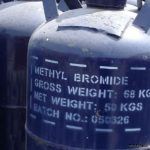Methyl Bromide: The Silent Toxic Threat in Pest Control
Methyl bromide might sound like just another chemical, but this odorless, colorless gas is one of the most dangerous fumigants still in limited use today. Once widely employed for pest control in agriculture and storage facilities, its terrifying toxicity has led to global restrictions—yet it still lingers in some industries, putting workers and ecosystems at risk.
This potent neurotoxin doesn’t just kill insects; it attacks the central nervous systems of any organism that inhales it. Farmers handling soil fumigation, warehouse workers treating stored goods, and even neighbors near application sites have all suffered from its effects. What makes methyl bromide particularly sinister is its ability to cause severe harm before victims even realize they’ve been exposed.
How Methyl Bromide Wreaks Havoc on the Body
 When methyl bromide enters the body through inhalation or skin contact, it disrupts the nervous system at a cellular level. The chemical interferes with enzyme systems critical for nerve function, essentially causing electrical signals in the brain and body to short-circuit. Early symptoms often mimic the flu—headaches, nausea, and dizziness—making accidental poisoning easy to miss until it’s too late.
When methyl bromide enters the body through inhalation or skin contact, it disrupts the nervous system at a cellular level. The chemical interferes with enzyme systems critical for nerve function, essentially causing electrical signals in the brain and body to short-circuit. Early symptoms often mimic the flu—headaches, nausea, and dizziness—making accidental poisoning easy to miss until it’s too late.
Severe exposure leads to terrifying neurological effects:
- Violent muscle twitching and seizures
- Pulmonary edema (fluid-filled lungs)
- Kidney failure
- Permanent brain damage
- Coma and death in extreme cases
The chemical’s fat solubility allows it to accumulate in the nervous system, meaning symptoms can appear hours after exposure when the damage is already done. Even low-level chronic exposure causes memory problems, personality changes, and coordination issues that may persist for years.
Environmental Impact: A Looming Ecological Disaster
Methyl bromide doesn’t just vanish after use—it rises into the atmosphere where it destroys ozone at a rate 60 times more potent than chlorine. This environmental double-whammy of extreme toxicity and ozone depletion led to its phase-out under the Montreal Protocol, though “critical use exemptions” still allow limited application in certain countries.
When the gas seeps into soil, it kills beneficial microorganisms crucial for plant growth. Aquatic ecosystems suffer tremendously when runoff occurs, with fish and amphibians being particularly sensitive to even trace amounts. The chemical’s persistence in the environment means a single application can have ripple effects through food chains for months.
Recognizing and Preventing Poisoning
Workers handling methyl bromide must wear specialized respirators and impermeable suits—ordinary protective gear isn’t enough. Warning signs of exposure include:
- A sweet, musty odor (though odorless at dangerous concentrations)
- Numbness in extremities
- Slurred speech
- Visual disturbances
If exposure occurs:
✓ Immediately move to fresh air
✓ Remove contaminated clothing
✓ Seek emergency medical attention
✓ Request blood and urine tests for bromide levels
Safer alternatives like phosphine gas, controlled atmosphere treatments, and heat sterilization now exist for most applications. Vigilance remains crucial as some facilities still illegally use stockpiled methyl bromide, putting countless lives at risk.
Chemical Properties and Health Effects
| Property | Specification |
|---|---|
| Chemical Formula | CH₃Br |
| Boiling Point | 3.56°C (38.4°F) |
| Vapor Density | 3.97 (heavier than air) |
| Odor Threshold | >200 ppm (often undetectable) |
| OSHA PEL | 5 ppm (8-hour TWA) |
| Lethal Concentration | 800 ppm (60-minute exposure) |
| Primary Targets | Nervous system, lungs, kidneys |
References and Sources
- CDC – NIOSH Methyl Bromide Guidelines
Comprehensive workplace safety standards and health monitoring protocols
URL: https://www.cdc.gov/niosh/npg/npgd0398.html - EPA – Methyl Bromide Phaseout
Regulatory timeline and current exemption status
URL: https://www.epa.gov/ods-phaseout/methyl-bromide - WHO – Chemical Safety Sheet
Medical treatment guidelines for poisoning cases
URL: https://www.who.int/
